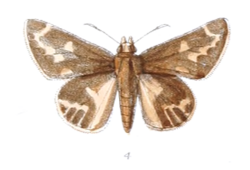Biology:Actinor
From HandWiki
Short description: Genus of butterflies
| Veined dart | |
|---|---|

| |
| Scientific classification | |
| Domain: | Eukaryota |
| Kingdom: | Animalia |
| Phylum: | Arthropoda |
| Class: | Insecta |
| Order: | Lepidoptera |
| Family: | Hesperiidae |
| Subfamily: | Hesperiinae |
| Tribe: | Astictopterini |
| Genus: | Actinor Watson, 1893 |
| Species: | A. radians
|
| Binomial name | |
| Actinor radians (Moore, 1878)
| |
| Synonyms | |
|
(Species)
| |
Actinor is a Himalayan genus of butterflies in the family Hesperiidae. It is monotypic, being represented by the single species Actinor radians, the veined dart.[1][2]
Description
Male. Upperside luteous-brown, basal hairy scales yellow. Cilia cinereous-white: forewing with a pale-yellow constricted spot at end of the cell, and an irregular transverse continuous discal band of spots with their lower angles continued outward along the veins; hindwing with a yellow streak at end of the cell and a short discal band with outer rays. Underside paler, minutely speckled with yellowish-white; forewing as above, the hind margin being also broadly yellow; hindwing with a subbasal spot, all the veins, and two (a median and a discal) transverse sinuous bands pale yellow. Palpi, body beneath and legs yellowish-white.—Edward Yerbury Watson, under Halpe radians 1891. Hesperiidae Indicae.[3]
Wingspan of 1.5 inches.
Distribution
The butterfly occurs from Chitral to Kumaon in the Himalayas up to 4,000 feet (1,200 m).[4]
Status
It is not rare.[4]
Cited references
- ↑ Markku Savela's website on Lepidoptera Page on genus Actinor.
- ↑ Brower, Andrew V. Z. 2007. Actinor Watson 1893. Actinor radians (Moore 1878). Version 4 March 2007 (under construction). [1] in The Tree of Life Web Project.
- ↑ Watson, E. Y. 1891. Hesperiidae Indicae. Vest and co. Madras
- ↑ 4.0 4.1 Evans, W.H. (1932). The Identification of Indian Butterflies (2nd ed.). Mumbai, India: Bombay Natural History Society. pp. 396, ser no I86.1.
See also
- Hesperiidae
- List of butterflies of India (Hesperiinae)
- List of butterflies of India (Hesperiidae)
References
- Evans, W.H. (1932). The Identification of Indian Butterflies (2nd ed.). Mumbai, India: Bombay Natural History Society.
- "Markku Savela's website on Lepidoptera". http://www.nic.funet.fi/pub/sci/bio/life/insecta/lepidoptera/.
- Tree of Life Web Project [2].
- Wynter-Blyth, Mark Alexander (1957). Butterflies of the Indian Region. Bombay, India: Bombay Natural History Society. ISBN 978-8170192329. https://books.google.com/books?id=yEkgAQAAMAAJ.
Wikidata ☰ {{{from}}} entry
 |

